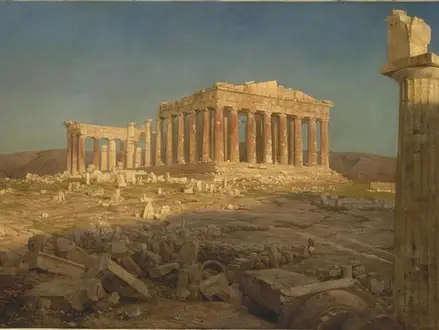Title of Artwork: “Parthenon”

Artwork by Frederic Edwin Church
Year Created 1871
Summary of Parthenon
Overlooking the world-famous Parthenon ruins, the setting sun casts a warm golden glow. This ancient citadel sits atop the Acropolis, a fortified mountaintop overlooking the city of Athens. The Parthenon was built in the 5th century BC, at the height of the Athenian Empire.
The Metropolitan Museum of Art in New York City has a monumental 1871 painting by American artist Frederic Edwin Church entitled The Parthenon.
It was in 1869 that he travelled to Greece to study the ruins of Parthenon, which later served as the basis for his work. Church was finally able to begin construction on his “big Parthenon” in 1871, thanks to a commission from financier and philanthropist Morris K. Jesup.
The enormous painting of the Parthenon by Frederic Edwin Church, “The Parthenon,” was completed in 1871. Between 447 and 432 B.C., the Acropolis of Athens, Greece, was home to the Parthenon, the world’s most famous temple.
After a direct hit by the Venetian besieging army in 1687, a Turkish gunpowder magazine located within the Temple exploded, causing the most extensive damage.
It also depicts the aftermath of Lord Elgin’s removal of many of its surviving sculptures between 1800 and 1803.
For his 1871 painting The Parthenon Ruins, American artist Frederic Church travelled to Athens in 1869 and made a series of detailed studies of the Parthenon ruins there.
All About Parthenon
Known as one of the world’s most significant cultural landmarks, the Parthenon endures as a lasting reminder of ancient Greece.
More than 2,500 years ago, when Athens was at the height of its power, workers began construction on the Parthenon, a temple dedicated to the goddess Athena.
Athens erected the Parthenon as a monument to commemorate their victory over the Persians as a uniting force of all Hellenes. It was also a way to express gratitude to the gods for their assistance.
In 480 BC, the Persians demolished an older Athena temple, and the Parthenon was built to take its place.
Acropolis was destroyed by Roman invasion of Athens, when successive Roman generals looted the Parthenon. Later, it was converted into a Christian church dedicated to the Virgin Mary, which was later incorporated into the Byzantine Empire.
In the early 1460s, the Parthenon was converted into a mosque following the Ottoman invasion and conquest of the country. In 1687, the building was used as an Ottoman ammunition dump and was blown up by the Venetians.
Damage to the sculptures and the Parthenon was extensive following the explosion. Lord Elgin removed many of the surviving sculptures between 1800 and 1803 and sold them to the British Museum in London in 1816.
Today, the Parthenon watches on, frightened but resolute, as a remarkable and inspiring survival storey unfolds before its eyes.
In Gallery 760 of the Metropolitan Museum of Art, you can see the painting.
Information Citations:
En.wikipedia.org, https://en.wikipedia.org/.























